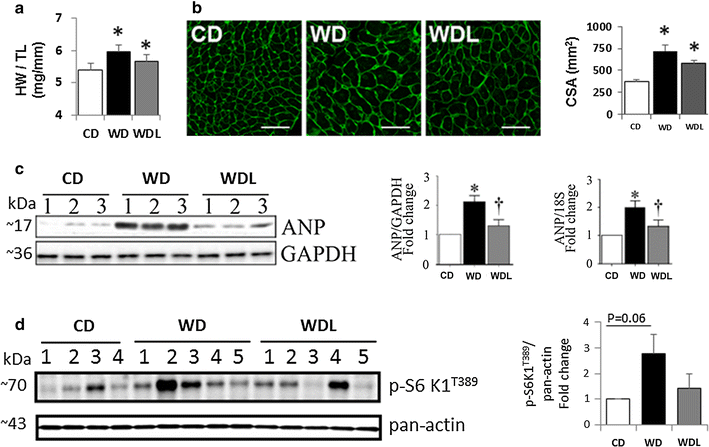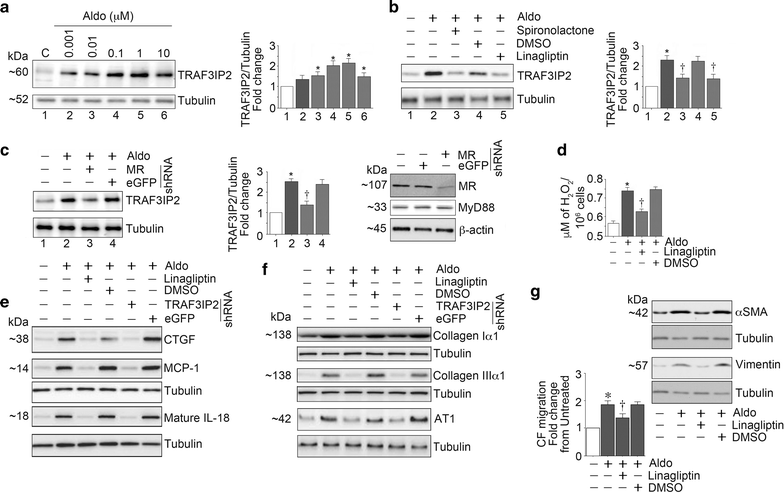Dipeptidyl peptidase-4 (DPP-4) inhibition with linagliptin reduces western diet-induced myocardial TRAF3IP2 expression, inflammation and fibrosis in female mice
- PMID: 28476142
- PMCID: PMC5420102
- DOI: 10.1186/s12933-017-0544-4
Dipeptidyl peptidase-4 (DPP-4) inhibition with linagliptin reduces western diet-induced myocardial TRAF3IP2 expression, inflammation and fibrosis in female mice
Abstract
Background: Diastolic dysfunction (DD), a hallmark of obesity and primary defect in heart failure with preserved ejection fraction, is a predictor of future cardiovascular events. We previously reported that linagliptin, a dipeptidyl peptidase-4 inhibitor, improved DD in Zucker Obese rats, a genetic model of obesity and hypertension. Here we investigated the cardioprotective effects of linagliptin on development of DD in western diet (WD)-fed mice, a clinically relevant model of overnutrition and activation of the renin-angiotensin-aldosterone system.
Methods: Female C56Bl/6 J mice were fed an obesogenic WD high in fat and simple sugars, and supplemented or not with linagliptin for 16 weeks.
Results: WD induced oxidative stress, inflammation, upregulation of Angiotensin II type 1 receptor and mineralocorticoid receptor (MR) expression, interstitial fibrosis, ultrastructural abnormalities and DD. Linagliptin inhibited cardiac DPP-4 activity and prevented molecular impairments and associated functional and structural abnormalities. Further, WD upregulated the expression of TRAF3IP2, a cytoplasmic adapter molecule and a regulator of multiple inflammatory mediators. Linagliptin inhibited its expression, activation of its downstream signaling intermediates NF-κB, AP-1 and p38-MAPK, and induction of multiple inflammatory mediators and growth factors that are known to contribute to development and progression of hypertrophy, fibrosis and contractile dysfunction. Linagliptin also inhibited WD-induced collagens I and III expression. Supporting these in vivo observations, linagliptin inhibited aldosterone-mediated MR-dependent oxidative stress, upregulation of TRAF3IP2, proinflammatory cytokine, and growth factor expression, and collagen induction in cultured primary cardiac fibroblasts. More importantly, linagliptin inhibited aldosterone-induced fibroblast activation and migration.
Conclusions: Together, these in vivo and in vitro results suggest that inhibition of DPP-4 activity by linagliptin reverses WD-induced DD, possibly by targeting TRAF3IP2 expression and its downstream inflammatory signaling.
Keywords: Diastolic dysfunction; Linagliptin; Myocardial fibrosis; Obesity; TRAF3IP2.
Figures










Similar articles
-
Mineralocorticoid receptor blockade prevents Western diet-induced diastolic dysfunction in female mice.Am J Physiol Heart Circ Physiol. 2015 May 1;308(9):H1126-35. doi: 10.1152/ajpheart.00898.2014. Epub 2015 Mar 6. Am J Physiol Heart Circ Physiol. 2015. PMID: 25747754 Free PMC article.
-
Endothelial Mineralocorticoid Receptor Deletion Prevents Diet-Induced Cardiac Diastolic Dysfunction in Females.Hypertension. 2015 Dec;66(6):1159-1167. doi: 10.1161/HYPERTENSIONAHA.115.06015. Epub 2015 Oct 5. Hypertension. 2015. PMID: 26441470 Free PMC article.
-
Dipeptidyl peptidase inhibition prevents diastolic dysfunction and reduces myocardial fibrosis in a mouse model of Western diet induced obesity.Metabolism. 2014 Aug;63(8):1000-11. doi: 10.1016/j.metabol.2014.04.002. Epub 2014 Apr 12. Metabolism. 2014. PMID: 24933400 Free PMC article.
-
The role of renal dipeptidyl peptidase-4 in kidney disease: renal effects of dipeptidyl peptidase-4 inhibitors with a focus on linagliptin.Clin Sci (Lond). 2018 Feb 28;132(4):489-507. doi: 10.1042/CS20180031. Print 2018 Feb 28. Clin Sci (Lond). 2018. PMID: 29491123 Free PMC article. Review.
-
The role of dipeptidylpeptidase-4 inhibitors in management of cardiovascular disease in diabetes; focus on linagliptin.Cardiovasc Diabetol. 2018 Apr 18;17(1):59. doi: 10.1186/s12933-018-0704-1. Cardiovasc Diabetol. 2018. PMID: 29669555 Free PMC article. Review.
Cited by
-
Alogliptin prevents diastolic dysfunction and preserves left ventricular mitochondrial function in diabetic rabbits.Cardiovasc Diabetol. 2018 Dec 27;17(1):160. doi: 10.1186/s12933-018-0803-z. Cardiovasc Diabetol. 2018. PMID: 30591063 Free PMC article.
-
Overview and New Insights into the Metabolic Syndrome: Risk Factors and Emerging Variables in the Development of Type 2 Diabetes and Cerebrocardiovascular Disease.Medicina (Kaunas). 2023 Mar 13;59(3):561. doi: 10.3390/medicina59030561. Medicina (Kaunas). 2023. PMID: 36984562 Free PMC article. Review.
-
DPP-4 inhibitors and heart failure: a potential role for pharmacogenomics.Heart Fail Rev. 2018 May;23(3):355-361. doi: 10.1007/s10741-017-9655-y. Heart Fail Rev. 2018. PMID: 28986727 Review.
-
The cAMP/PKA signaling pathway conditions cardiac performance in experimental animals with metabolic syndrome.J Mol Cell Cardiol. 2024 Nov;196:35-51. doi: 10.1016/j.yjmcc.2024.09.002. Epub 2024 Sep 7. J Mol Cell Cardiol. 2024. PMID: 39251059
-
Therapeutic potential of targeting oxidative stress in diabetic cardiomyopathy.Free Radic Biol Med. 2021 Jun;169:317-342. doi: 10.1016/j.freeradbiomed.2021.03.046. Epub 2021 Apr 25. Free Radic Biol Med. 2021. PMID: 33910093 Free PMC article. Review.
References
-
- Peterson LR, Waggoner AD, Schechtman KB, Meyer T, Gropler RJ, Barzilai B, Davila-Roman VG. Alterations in left ventricular structure and function in young healthy obese women: assessment by echocardiography and tissue doppler imaging. J Am Coll Cardiol. 2004;43(8):1399–1404. doi: 10.1016/j.jacc.2003.10.062. - DOI - PubMed
-
- Peterson LR, Saeed IM, McGill JB, Herrero P, Schechtman KB, Gunawardena R, Recklein CL, Coggan AR, Demoss AJ, Dence CS, et al. Sex and type 2 diabetes: obesity-independent effects on left ventricular substrate metabolism and relaxation in humans. Obesity (Silver Spring) 2012;20(4):802–810. doi: 10.1038/oby.2011.208. - DOI - PMC - PubMed
Publication types
MeSH terms
Substances
Grants and funding
LinkOut - more resources
Full Text Sources
Other Literature Sources
Medical
Miscellaneous

